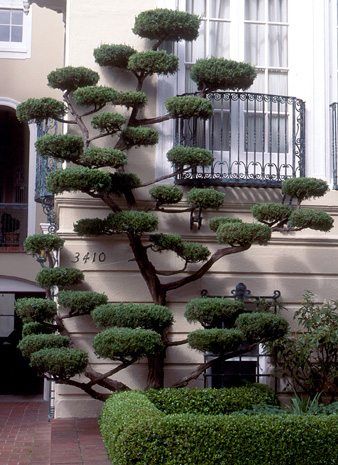na·gi (nä´gē) n. any of a small genus of conifer trees (Nageia J.Gaertner, of the Podocarpaceae), native to southeast Asia and Melanesia, bearing opposite somewhat elliptical leaves which resemble those of the unrelated kauri. The genus is often cultivated as an ornamental, and its wood is of some use for construction and craft. [J.]
nan·ny·ber·ry (nan´ē bãr´ē) n. -ries. 1 a tall shrub or small tree native to eastern temperate North America (Viburnum lentago L., of the Caprifoliaceae), bearing large corymbs of small white flowers, and later blue drupelets which are a staple winter diet item for small birds. 2 the fruit of this shrub. [< E nanny goat + berry]
neck·lace (nek´ləs) n. a horizontal cut through the cork of a tree to the phellogen, made to form the upper limit of an area of cork harvested. It is often placed at a height roughly 3 times the circumference of the trunk, which usually coincides with an easily accessible height above ground. [tr. of Sp. collar]
neis·hout (nās´out) n. sneezewood. [< Du. niezen sneeze + hout wood]
Nel·dor·eth (nel´do ɾeth´) n. in LOTR, a forest of great beech trees in northern Doriath, where Lúthien Tinuviel was born. [S neldoreth beech-land < neldor beech]
nine·bark (nīn´bark) n. 1 any of several shrub species of the largely North American genus Physocarpus (Cambess.) Raf. (of the Rosaceae), closely-related to Spiraea L. (also of the Rosaceae) and previously regarded as a sectio of the latter genus. 2 the shrub Hydrangea arborescens L. subsp. radiata (Walter) E.M.McClint. (of the Hydrangeaceae), a North American shrub of the Blue Ridge Mountains; silverleaf. [Americanism; descriptive of the exfoliating bark of these genera]
ni·val (nē´vəl or nī´vəl) adj. of snowy terrains, or growing in snow. [< L nivālis < nix snow + -alis growing in, or pertaining to]
ni·wa·ki (nē wä´kē) n. an artistic pruning method for trees, often directed at making the tree appear more aged, by creating a writhing or wide stem and foliage resembling clouds. [< J. にわき < にわ (niwa) garden + き (ki) tree]
nod·ding (nod´ing) adj. of a flower or compact inflorescence, having the superior face bent downwards; cernuous.
non·con·for·ming (non´kon fôr´ming) adj. of species ranges: unrelated and/or dissimilar in extent and outline. [< L non- not + ME confourmen (< MF conformer < L confōrmāre to shape) + E -ing participial adjective suffix]
non·po·rous (non pôr´əs) adj. 1 of tissue, lacking pores which allow for the absorption of fluids, such as water, or air. 2 of wood, displaying pores due to either of tracheids or xylem vessels which are so tiny in cross-section as to appear absent. [< L non- not + OF poreux porous]
no·pal (nō päl´) n. no·pa·les (nō pä´lez). 1 an edible cactus stem segment of the genus Nopalea cochenillifera (L.) Salm-Dyck (of the Cactaceae), frequently employed in Mexican dishes. 2 the plant from which these stem segments derive, native to Mexico and also serving as a food source for cochineal insects; rachet. [Sp. < Nahuatl nopalli cactus]
nul·li·pore (nul´i pōr´) n. any of several seaweeds and algae which secrete lime. [< L nullus none + porus pore] —nul´li·po´rous, adj.
nun·chuk (nən´chək´) n. nun·chuk. an implement of two hardwood rods, each less than a cubit in length, fixed to each other at one end by a thong or short chain, and designed for flailing or threshing harvested grain. It is mainly known now as an implement of jiujitsu. [< J. (dial. of Okinawa) ヌンチャク (nunchaku) twin joined sticks]
nu·tant (nü´tənt or nū´-) adj. nodding, drooping. [< L nūtāre nod]

